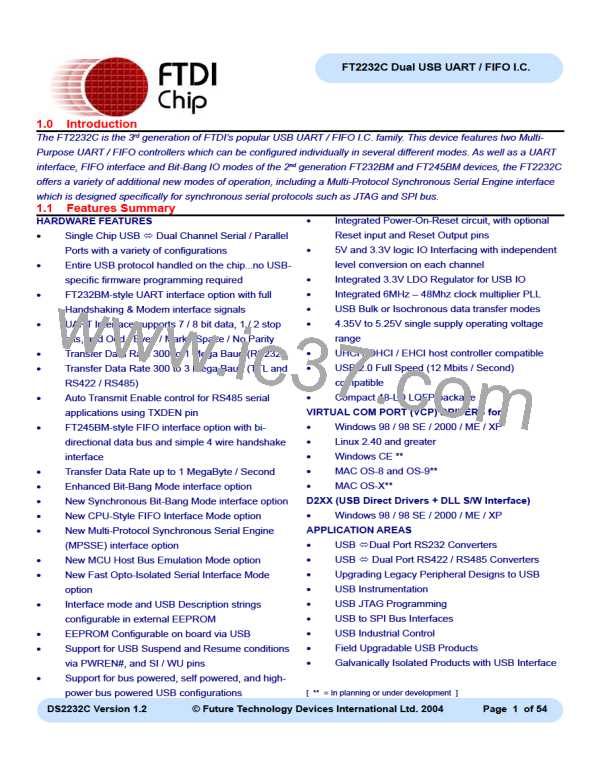FT2232C Dual USB UART / FIFO I.C.
Figure 16 - USB <=> RS485 Converter Configuration
DB9-M
RS485 Channel A
FT2232C
41
13
VCC
SP481
PWREN#
8
3
SLEEP# (ACBUS1)
7
6
DM_A
DPA
24
23
22
21
20
19
17
16
15
4
2
1
TXD (ADBUS0)
RXD (ADBUS1)
RTS# (ADBUS2)
CTS# (ADBUS3)
DTR# (ADBUS4)
DSR# (ADBUS5)
DCD# (ADBUS6)
RI# (ADBUS7)
D
R
GND
5
120R
LINK
TXDEN (ACBUS0)
DB9-M
RS485 Channel B
VCC
SP481
8
29
40
39
38
37
36
35
33
32
30
3
SLEEP# (BCBUS1)
TXD (BDBUS0)
RXD (BDBUS1)
RTS# (BDBUS2)
CTS# (BDBUS3)
DTR# (BDBUS4)
DSR# (BDBUS5)
DCD# (BDBUS6)
RI# (BDBUS7)
7
DM_B
DP_B
GND
4
2
1
D
6
R
5
120R
LINK
TXDEN (BCBUS0)
Figure 16 illustrates how to connect the UART interfaces of the FT2232C to two TTL – RS485 Level Converter I.C.’s
to make a USB to dual port RS485 converter. This example uses two Sipex SP491 devices but there are similar parts
available from Maxim and Analog Devices amongst others. The SP491 is a RS485 device in a compact 8 pin SOP
package. It has separate enables on both the transmitter and receiver. With RS485, the transmitter is only enabled
when a character is being transmitted from the UART. The TXDEN pins on the FT2232C are provided for exactly that
purpose, and so the transmitter enables are wired to the TXDEN’s. The receiver enable is active low, so it is wired to
the PWREN# pin to disable the receiver when in USB suspend mode.
RS485 is a multi-drop network – i.e. many devices can communicate with each other over a single two wire cable
connection. The RS485 cable requires to be terminated at each end of the cable. Links are provided to allow the cable
to be terminated if the device is physically positioned at either end of the cable.
In this example the data transmitted by the FT2232C is also received by the device that is transmitting. This is a
common feature of RS485 and requires the application software to remove the transmitted data from the received
data stream. With the FT2232C it is possible to do this entirely in hardware – simply modify the schematic so that RXD
of the FT2232C is the logical OR of the SP481 receiver output with TXDEN using an HC32 or similar logic gate.
DS2232C Version 1.2
© Future Technology Devices International Ltd. 2004
Page 31 of 54

 FTDI [ FUTURE TECHNOLOGY DEVICES INTERNATIONAL LTD. ]
FTDI [ FUTURE TECHNOLOGY DEVICES INTERNATIONAL LTD. ]